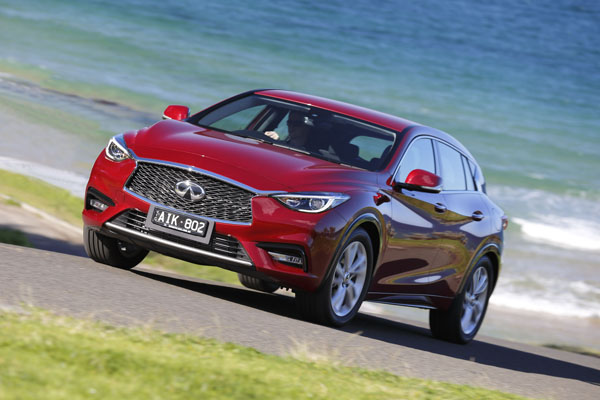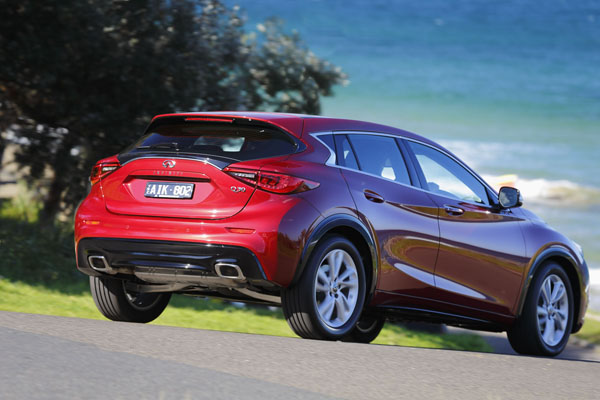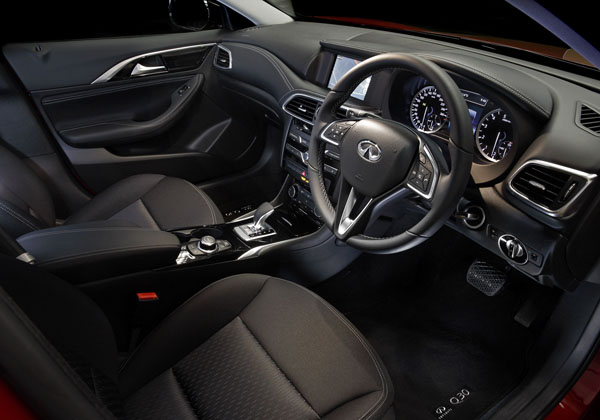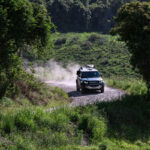 Since its return to Australia four years ago Infiniti has gone about quietly making inroads into the Australian market. Now, that is to be ramped up with plans for seven models to land by year’s end.
Since its return to Australia four years ago Infiniti has gone about quietly making inroads into the Australian market. Now, that is to be ramped up with plans for seven models to land by year’s end.
First cab off the rank is the Infiniti Q30, which the Japanese company calls an ‘active compact vehicle’, which the company expects to become the volume model. The Q30 comes in three model grades with three engine choices.
Infiniti Q30 is available in three model grades; GT, Sport or Sport Premium. The Q30 Sport model sits 15 mm lower than the GT, while individual suspension settings produce a distinctive ride and handling.
The Q30 cuts a dash with an edgy exterior. Headlamps with a distinctive feline appearance flank Infiniti’s signature double-arch radiator grille; a thin A-pillar gives the driver a clearer three-quarter view; a coupe-like profile is emphasised by a sharp hip line crease and shallow glassed area extending to a crescent-cut rear.
The Q30 GT includes LED front foglamps, body-coloured and heated door mirrors, as well as satin chrome dual rectangular exhaust tips, while 18-inch alloy wheels add to the overall striking appearance.
Sport models feature different guards, gloss black grille and 19-inch alloy wheels. The rear bumper is differentiated by dark chrome dual rectangular exhaust finishers.
Interior designers chose high quality materials to create a modern-looking and luxurious cabin. A super-soft, tactile material is used to line many of the surfaces, such as door trims and the centre armrest, to which occupants have most contact.
Dinamica, a new Italian suede-like material used increasingly in the high-fashion industry, has been applied to the roof-line and pillars, and Q30’s seats are upholstered in premium materials such as Nappa Leather and Alcantara.
The entry-level GT comes with a 1.6-litre turbocharged petrol engine, while the Sport and Sport Premium are available with either a 2.0-litre turbocharged petrol engine or 2.2-litre turbocharged diesel.
Prices start at $38,900, plus on-road costs ($42,875 estimated driveaway) for the 1.6-litre petrol GT, while the range-topping 2.2-litre diesel Sports Premium tips the scales at $54,900 ($59,335).
The free-revving turbocharged 1.6-litre petrol engine delivers 115 kW of power and 250 Nm of torque, resulting in acceleration from zero to 100 km/h in 8.9 seconds. Combined urban / highway fuel consumption is 6.0 litres per 100 km with carbon dioxide emissions of 139 g/km.
The 155 kW / 350 Nm 2.0-litre turbo-petrol engine powers the Q30 Sport and Sport Premium models to 100 km/h in 7.3 seconds. Fuel consumption is 6.3 litres per 100km with a CO2 output of 147 g/km.
The 2.2-litre turbo-diesel comes up with 125 kW of power and peak torque of 350 Nm from an accessible 1400 to 3400 rpm has fuel consumption rate of 5.2 litres per 100 km (with a CO2 output of 120 g/km).This unit is used in the Q30 Sport and Sport Premium models clocking a respectable 8.3 seconds for the sprint from rest.
All models rely on a seven-speed dual-clutch automatic transmission, tuned especially to suit the Q30 offering near seamless up and down-shifts.
Space and practicality are not compromised by the coupe-like exterior; occupants and luggage enjoy some of the best in the segment, notably the 430-litre boot, which thanks to a wide aperture and square dimensions, easily takes two large suitcases, with 60:40 split-fold rear passenger seats freeing up even more room.
The Q30 interior has been engineered to minimise driver fatigue and deliver a high degree of comfort through a low level of noise, vibration and harshness in the cabin. Aided by a rigid body shell, the extensive use of sound-absorbent materials and new audio technology, resulting in what we are told is a 10 per cent advantage over the competition in audibility at speeds of up to 120 km/h.
Added to this, in the 2.2-litre diesel variant, is a new Active Noise Cancellation (ANC) system, which emits sound waves through the four door speakers to counteract noises that may distract and fatigue the driver, such as low frequency booming from the engine.
In a run at launch through Sydney and to the south, this was particularly noticed in terms of cabin quietness of the diesel in comparison to its petrol counterpart – slightly unnerving if the presence of the ANC was unknown.
The two larger engine Q30s also benefit from Active Sound Control, which monitors the throttle pedal position, engine speed and road speed, and works to smooth out any variations in engine tone to project a pleasing sound under acceleration.
Infiniti Q30’s seats feature so-called ‘zero gravity seats’ have been engineered to match the curvature of the spine, providing a consistent level of support and minimising pressure on lower and upper back muscles, replacing the spinal curvature that many traditional seats force occupants to adopt with a more even alignment between chest and pelvis.
Extensive upper body support also spreads the occupants’ weight more evenly all the way up the chair. This technology also is applied in the Sports seats fitted to the Q30 upper-level models.
The Infiniti holds a steady course on the road thanks to specially tuned shock absorbers, while the ride remains consistently smooth and comfortable. Enhanced body stiffness, hence low NVH, plus responsive linear steering, deliver the driver a feeling of being in complete control.
The Brembo brake package was designed especially for Infiniti to give the Q30 a linear build-up of performance under hard braking, particularly from high speeds, and an overall progressive feel. Light braking delivers a strong initial ‘bite’ and for emergencies ‘over delivers’, bringing the vehicle to a safe and immediate stop.
Active safety features include ABS anti-skid brakes with brake assist and electronic brake-force distribution. The park brake is electronic. Driving assistance technology is offered in various forms across the Q30 range. Included are forward collision warning with forward emergency braking, auto high beam assist, intelligent cruise control and intelligent park assist.
Drivers can tailor the Q30 to their preference through the Drive Mode Selector, offering Standard, Eco or Sport by changing engine and transmission settings to suit driving style – from instant urging to fuel saving somnambulance.
Infiniti’s own InTouch infotainment system, first introduced on the Q50, has been upgraded to give intuitive tablet-style operation by the driver via a 7.0-inch touch screen on the centre console. A range of InTouch apps on offer are designed to make the journey safer and more enjoyable.
Key information is also displayed on the dashboard directly in front of the driver, while Bluetooth hands-free connectivity cuts down distractions for the person behind the wheel.
Australasian New Car Assessment Program praised Infiniti for making Autonomous Emergency Braking standard in the new Q30. It has a five-star safety rating.
Built in a new multimillion dollar bespoke plant in Sunderland, UK, the Q30 stays true to the concept revealed at the 2013 Frankfurt Motor Show. It’s an in-house development designed and engineered to meet exacting Infiniti standards.
High-spec standard features are the name of the game with the Q30, the only option being a Bose Premium Sound system. Infiniti offers a warranty of four years or 100,000 km, while service intervals are 12 months or 25,000 kilometres
AT A GLANCE
MODEL LINE-UP
Infiniti Q30 1.6t GT $38,900 ($42,875, approx. driveaway)
Infiniti Q30 2.0t Sports $44,900 ($49,055)
Infiniti Q30 2.0t Sports, with Bose Sound, $45,900 ($50,085)
Infiniti Q30 2.2d Sports $46,900 ($52,145)
Infiniti Q30 2.2d Sports, with Bose Sound, $47,900 ($53,175)
Infiniti Q30 2.0t Sports Premium $52,900 ($57,295)
Infiniti Q30 2.2d Sports Premium $54,900 ($59,335)
Note: These prices do not include dealer or government charges. Contact your local Infiniti dealer for drive-away prices.











